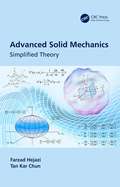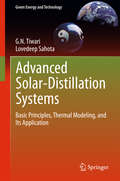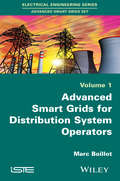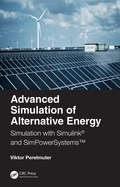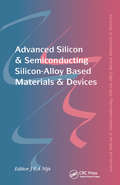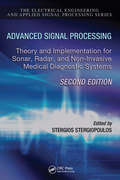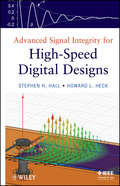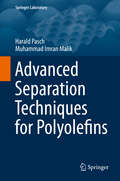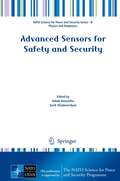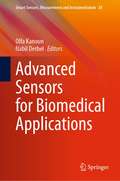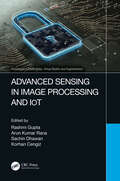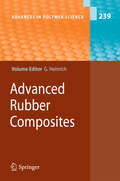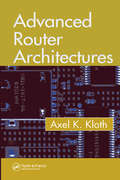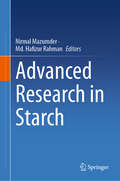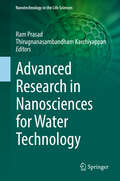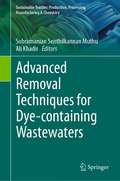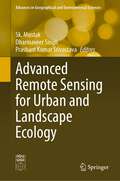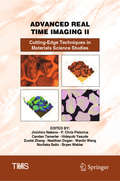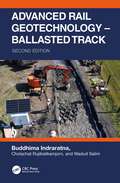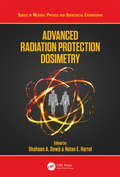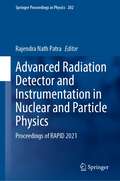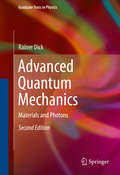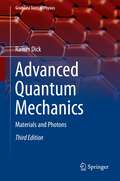- Table View
- List View
Advanced Solid Mechanics: Simplified Theory
by Farzad Hejazi Tan Kar ChunThe main aim of this book is to demonstrate the fundamental theory of advanced solid mechanics through simplified derivations with details illustrations to deliver the principal concepts. It covers all conceptual principals on two- and three-dimensional stresses, strains, stress-strain relations, theory of elasticity and theory of plasticity in any type of solid materials including anisotropic, orthotropic, homogenous and isotropic. Detailed explanation and clear diagrams and drawings are accompanied with the use of proper jargons and notations to present the ideas and appropriate guide the readers to explore the core of the advanced solid mechanics backed by case studies and examples. Aimed at undergraduate, senior undergraduate students in advanced solid mechanics, solid mechanics, strength of materials, civil/mechanical engineering, this bookProvides simplified explanation and detailed derivation of correlation and formula implemented in advanced solid mechanics Covers state of two and three-dimensional stresses and strains in solid materials in various conditionsDescribes principal constitutive models for various type of materials include of anisotropic, orthotropic, homogenous and isotropic materials. Includes stress-strain relation and theory of elasticity for solid materials. Explores inelastic behaviour of material, theory of plasticity and yielding criteria.
Advanced Solar-Distillation Systems: Basic Principles, Thermal Modeling, and Its Application (Green Energy and Technology)
by G. N. Tiwari Lovedeep SahotaThis book is primarily intended to serve as a textbook and reference work for graduate and professional training coursework on solar desalination of water. The book begins with an introduction to the increasing demand for potable water, various types of water pollution and its impacts on human health, and goes on to cover basics of desalination technologies. It covers all aspects of solar-energy based distillation and desalination for producing potable water resources, including radiation and heat transfer concepts, a history of solar distillation systems, and background on solar collectors. The contents include thermal modeling and parametric study of solar distillation. Energy and exergy aspects are analyzed in detail, including energy matrices of solar distillation. A special chapter on exeroeconomics introduces fundamental equations which include the general balance equation, thermodynamic balance equations, and economic balance equations. A chapter on Economic Analysis of Solar Distillation completes the coverage. The book includes solved examples and end-of-chapter exercises in the form of both problems and objective-type questions. The contents of this book are useful to students, researchers, professionals, and policymakers looking for a comprehensive resource on solar desalination.
Advanced Smartgrids for Distribution System Operators
by Marc BoillotThe dynamic of the Energy Transition is engaged in many region of the World. This is a real challenge for electric systems and a paradigm shift for existing distribution networks. With the help of "advanced" smart technologies, the Distribution System Operators will have a central role to integrate massively renewable generation, electric vehicle and demand response programs. Many projects are on-going to develop and assess advanced smart grids solutions, with already some lessons learnt. In the end, the Smart Grid is a mean for Distribution System Operators to ensure the quality and the security of power supply.Several books have been written to provide a definition of Smart grids, explore the different technical evolution needed and explain / analyse what would be the benefits. All those books are conducted on theoretical basis by academics and strategy consultants. This new book will propose a complementary and singular approach based on a practical experience from DSO's.
Advanced Simulation of Alternative Energy: Simulation with Simulink® and SimPowerSystems™
by Viktor M. PerelmuterAdvanced Simulation of Alternative Energy: Simulations with Simulink® and SimPowerSystems™ considers models of new and promising installations of renewable energy sources, as well as the new trends in this technical field. The book is focused on wind generators with multiphase generators, models of different offshore parks, wind shear and tower shadow effect, active damping, system inertia support, synchronverter modeling, photovoltaic cells with cascaded H-Bridge multilevel inverters, operation of fuel cells with electrolyzers and microturbines, utilization of ocean wave and ocean tide energy sources, pumped storage hydropower simulation, and simulation of some hybrid systems. Simulink® and its toolbox, SimPowerSystems™ (its new name Electrical/Specialized Power Systems), are the most popular means for simulation of these systems. More than 100 models of the renewable energy systems that are made with use of this program environment are appended to the book. The aims of these models are to aid students studying various electrical engineering fields including industrial electronics, electrical machines, electrical drives, and production and distribution of electrical energy; to facilitate the understanding of various renewable energy system functions; and to create a platform for the development of systems by readers in their fields. This book can be used by engineers and investigators as well as undergraduate and graduate students to develop new electrical systems and investigate the existing ones.
Advanced Silicon & Semiconducting Silicon-Alloy Based Materials & Devices
by Johan F A NijsOne of the first books to cover advanced silicon-based technologies, Advanced Silicon and Semiconducting Silicon Alloy-Based Materials and Devices presents important directions for research into silicon, its alloy-based semiconducting devices, and its development in commercial applications. The first section deals with single/mono crystalline silicon, focusing on the effects of heavy doping; the structure and electronic properties of defects and their impact on devices; the MBE of silicon, silicon alloys, and metals; CVD techniques for silicon and silicon germanium; the material properties of silicon germanium strained layers; silicon germanium heterojunction bipolar applications; FETs, IR detectors, and resonant tunneling devices in silicon, silicon germanium, and d-doped silicon; and the fascinating properties of crystalline silicon carbide and its applications. The second section explores polycrystalline silicon. It examines large grain polysilicon substrates for solar cells; the properties, analysis, and modeling of polysilicon TFTs; the technology of polysilicon TFTs in LCD displays; and the use of polycrystalline silicon and its alloys in VLSI applications. With contributors from leading academic and industrial research centers, this book provides wide coverage of fabrication techniques, material properties, and device applications.
Advanced Signal Processing: Theory and Implementation for Sonar, Radar, and Non-Invasive Medical Diagnostic Systems, Second Edition (Electrical Engineering & Applied Signal Processing Series)
by Stergios StergiopoulosDiscover the Applicability, Benefits, and Potential of New Technologies As advances in algorithms and computer technology have bolstered the digital signal processing capabilities of real-time sonar, radar, and non-invasive medical diagnostics systems, cutting-edge military and defense research has established conceptual similarities in these areas. Now civilian enterprises can use government innovations to facilitate optimal functionality of complex real-time systems. Advanced Signal Processing details a cost-efficient generic processing structure that exploits these commonalities to benefit commercial applications. Learn from a Renowned Defense Scientist, Researcher, and Innovator The author preserves the mathematical focus and key information from the first edition that provided invaluable coverage of topics including adaptive systems, advanced beamformers, and volume visualization methods in medicine. Integrating the best features of non-linear and conventional algorithms and explaining their application in PC-based architectures, this text contains new data on: Advances in biometrics, image segmentation, registration, and fusion techniques for 3D/4D ultrasound, CT, and MRI Fully digital 3D/ (4D: 3D+time) ultrasound system technology, computing architecture requirements, and relevant implementation issues State-of-the-art non-invasive medical procedures, non-destructive 3D tomography imaging and biometrics, and monitoring of vital signs Cardiac motion correction in multi-slice X-ray CT imaging Space-time adaptive processing and detection of targets interference-intense backgrounds comprised of clutter and jamming With its detailed explanation of adaptive, synthetic-aperture, and fusion-processing schemes with near-instantaneous convergence in 2-D and 3-D sensors (including planar, circular, cylindrical, and spherical arrays), the quality and illustration of this text’s concepts and techniques will make it a favored reference.
Advanced Signal Integrity for High-Speed Digital Designs
by Stephen H. Hall Howard L. HeckA synergistic approach to signal integrity for high-speed digital designThis book is designed to provide contemporary readers with an understanding of the emerging high-speed signal integrity issues that are creating roadblocks in digital design. Written by the foremost experts on the subject, it leverages concepts and techniques from non-related fields such as applied physics and microwave engineering and applies them to high-speed digital design--creating the optimal combination between theory and practical applications.Following an introduction to the importance of signal integrity, chapter coverage includes:Electromagnetic fundamentals for signal integrityTransmission line fundamentalsCrosstalkNon-ideal conductor models, including surface roughness and frequency-dependent inductanceFrequency-dependent properties of dielectricsDifferential signalingMathematical requirements of physical channelsS-parameters for digital engineersNon-ideal return paths and via resonanceI/O circuits and modelsEqualizationModeling and budgeting of timing jitter and noiseSystem analysis using response surface modelingEach chapter includes many figures and numerous examples to help readers relate the concepts to everyday design and concludes with problems for readers to test their understanding of the material. Advanced Signal Integrity for High-Speed Digital Designs is suitable as a textbook for graduate-level courses on signal integrity, for programs taught in industry for professional engineers, and as a reference for the high-speed digital designer.
Advanced Separation Techniques for Polyolefins (Springer Laboratory)
by Harald Pasch Muhammad Imran MalikThis Springer Laboratory volume introduces the reader to advanced techniques for the separation and fractionation of polyolefins. It includes detailed information on experimental protocols and procedures, addressing the experimental background of different polyolefin fractionation techniques in great detail. The book summarizes important applications in all major fractionation methods with emphasis on multidimensional analytical approaches. It comprises the most powerful modern techniques, such as high temperature size exclusion chromatography (HT-SEC) for molar mass analysis, temperature rising elution fractionation (TREF) and crystallization analysis fractionation (CRYSTAF) for the analysis of chemical composition and branching, high temperature two-dimensional liquid chromatography (HT-2D-LC), solvent and temperature gradient interaction chromatography (SGIC and TGIC) and crystallization elution fractionation (CEF). Beginners as well as experienced chromatographers will benefit from this concise introduction to a great variety in instrumentation, separation procedures and applications. With detailed descriptions of experimental approaches for the analysis of complex polyolefins, the readers are offered a toolbox to solve simple as well as sophisticated separation tasks. The book starts with an introduction into the molecular complexity of polyolefins - the most widely used synthetic polymers with rapidly growing production capacities. It systematically discusses crystallization based fractionation techniques including TREF, CRYSTAF and CEF and column chromatographic techniques for molar mass, chemical composition and microstructure, as well as the combination of different fractionations in multidimensional experimental setups. This book also includes basic information on the application of high-temperature field-flow fractionation.
Advanced Sensors for Safety and Security (NATO Science for Peace and Security Series B: Physics and Biophysics)
by Ashok Vaseashta Surik KhudaverdyanThis book results from a NATO Advanced Research Workshop titled "Technological Innovations in CBRNE Sensing and Detection for Safety, Security, and Sustainability" held in Yerevan, Armenia in 2012. The objective was to discuss and exchange views as to how fusion of advanced technologies can lead to improved sensors/detectors in support of defense, security, and situational awareness. The chapters range from policy and implementation, advanced sensor platforms using stand-off (THz and optical) and point-contact methods for detection of chemical, nuclear, biological, nuclear and explosive agents and contaminants in water, to synthesis methods for several materials used for sensors. In view of asymmetric, kinetic, and distributed nature of threat vectors, an emphasis is placed to examine new generation of sensors/detectors that utilize an ecosystems of innovation and advanced sciences convergence in support of effective counter-measures against CBRNE threats. The book will be of considerable interest and value to those already pursuing or considering careers in the field of nanostructured materials, and sensing/detection of CBRNE agents and water-borne contaminants. For policy implementation and compliance standpoint, the book serves as a resource of several informative contributions. In general, it serves as a valuable source of information for those interested in how nanomaterials and nanotechnologies are advancing the field of sensing and detection using nexus of advanced technologies for scientists, technologists, policy makers, and soldiers and commanders.
Advanced Sensors for Biomedical Applications (Smart Sensors, Measurement and Instrumentation #38)
by Olfa Kanoun Nabil DerbelThe book highlights recent developments in the field of biomedical sensors with a focus on technology and design aspects of novel sensors and sensor systems. Diagnosis plays a central role in healthcare and requires a variety of novel biomedical sensors and sensor systems. This creates an enormous ongoing demand for sensors for both the everyday life as well as for medical care. Technologies concerning the analysis of human activities as well as for the early detection of diseases are moving into the focus of interest and form the basis for supporting human health and quality of life. As such, the book offers a key reference guide about novel medical sensors and systems for students, engineers, sensors designers and technicians.
Advanced Sensing in Image Processing and IoT (Innovations in Multimedia, Virtual Reality and Augmentation)
by Rashmi Gupta, Arun Kumar Rana, Sachin Dhawan, and Korhan CengizThe book provides future research directions in IoT and image processing based Energy, Industry, and Healthcare domain and explores the different applications of its associated technologies. However, the Internet of Things and image processing is a very big field with a lot of subfields, which are very important such as Smart Homes to improve our daily life, Smart Cities to improve the citizens' life, Smart Towns to recover the livability and traditions, Smart Earth to protect our world, and Industrial Internet of Things to create safer and easier jobs. This book considers very important research areas in Energy, Industry, and Healthcare domain with IoT and image processing applications.The aim of the book to highlights future directions of optimization methods in various engineering and science applications in various IoT and image processing applications. Emphasis is given to deep learning and similar models of neural network-based learning techniques employed in solving optimization problems of different engineering and science applications. The role of AI in mechatronics is also highlighted using suitable optimization methods. This book considers very important research areas in Energy, Industry, and Healthcare. It addresses major issues and challenges in Energy, Industry, and Healthcare and solutions proposed for IoT-enabled cellular/computer networks, routing/communication protocols, surveillances applications, secured data management, and positioning approaches. It focuses mainly on smart and context-aware implementations. Key sailing Features: The impact of the proposed book is to provide a major area of concern to develop a foundation for the implementation process of new image processing and IoT devices based on Energy, Industry, and Healthcare related technology. The researchers working on image processing and IoT devices can correlate their work with other requirements of advanced technology in Energy, Industry, and Healthcare domain. To make aware of the latest technology like AI and Machine learning in Energy, Industry, and Healthcare related technology. Useful for the researcher to explore new things like Security, cryptography, and privacy in Energy, Industry, and Healthcare related technology. People who want to start in Energy, Industry, and Healthcare related technology with image processing and IoT world.
Advanced Rubber Composites (Advances in Polymer Science #239)
by Gert HeinrichMorphology-Property Relationship in Rubber-Based Nanocomposites: Some Recent Developments, by A. K. Bhowmick, M. Bhattacharya, S. Mitra, K. Dinesh Kumar, P. K. Maji, A. Choudhury, J. J. George and G. C. Basak; * Rubber-Clay Nanocomposites: Some Recent Results, by Amit Das, De-Yi Wang, Klaus Werner Stöckelhuber, René Jurk, Juliane Fritzsche, Manfred Klüppel and Gert Heinrich; * Surface Modification of Fillers and Curatives by Plasma Polymerization for Enhanced Performance of Single Rubbers and Dissimilar Rubber/Rubber Blends, by J. W. M. Noordermeer, R. N. Datta, W. K. Dierkes, R. Guo, T. Mathew, A. G. Talma, M. Tiwari and W. van Ooij; * Recent Developments on Thermoplastic Elastomers by Dynamic Vulcanization, by R. Rajesh Babu and Kinsuk Naskar; * PTFE-Based Rubber Composites for Tribological Applications, by M. S. Khan and G. Heinrich
Advanced Router Architectures
by Axel K. KlothRouters, switches, and transmission equipment form the backbone of the Internet, yet many users and service technicians do not understand how these nodes really work.Advanced Router Architectures addresses how components of advanced routers work together and how they are integrated with each other. This book provides the background behind why these building blocks perform certain functions, and how the function is implemented in general use. It offers an introduction to the subject matter that is intended to trigger deeper interest from the reader. The book explains, for example, why traffic management may be important in certain applications, what the traffic manager does, and how it connects to the rest of the router. The author also examines the implications of the introduction or omission of a traffic manager into an advanced router. The text offers a similar analysis for other router topics such as QOS and policy enforcement, security processing (including DoS/DDoS), and more.This book covers which mandatory and which optional building blocks can be found in an advanced router, and how these building blocks operate in conjunction to ensure that the Internet performs as expected.
Advanced Research in Starch
by Nirmal Mazumder Md. Hafizur RahmanThis book focuses on the various invasive and non-invasive techniques which can be used for the characterization of starch macromolecules along with, the various types of physical, chemical, and enzymatic modifications of starch to enhance its usage in the food industry. It discusses various biophysical techniques, including scanning electron microscopy, Fourier transforms infrared spectroscopy, X-ray diffraction, Raman scattering, and second harmonic generation microscopy for the understanding of the Physico-chemical properties of starch. The book also sheds light on the visual, rheological characterization of different types of starches that are responsible for altered digestibility. The chapters also cover the applications of starch in food industries, non-food industries, pharmaceuticals, drug delivery systems, and green flexible electronics. Towards the end, the book reviews the chemical, physical, and enzymatic modifications of the starch for improving its properties and applications. This book provides a valuable reference for students and researchers in the field of food science and technology, food science, and nutrition.
Advanced Research in Nanosciences for Water Technology (Nanotechnology in the Life Sciences)
by Ram Prasad Thirugnanasambandham KarchiyappanThe establishment of clean, safe water is one of the major challenges facing societies around the globe. The continued urbanization of human populations, the increasing manipulation of natural resources, and the resulting pollution are driving remarkable burden on water resources. Increasing demands for food, energy, and natural resources are expected to continue to accelerate in the near future in response to the demands of these changing human populations. In addition, the complexity of human activities is leading to a diversity of new chemical contaminants in the environment that represent a major concern for water managers. This will create increased pressure on both water quantity and quality, making it increasingly difficult to provide a sustainable supply of water for human welfare and activities. Although protection of water resources is the best long-term solution, we will also need innovative novel approaches and technologies to water treatment to ensure an adequate superior quality resource to meet these needs. Solving tomorrow’s water issues will require unique approaches that incorporate emerging new technologies. Great advances have been made in the area of nanotechnology. Due to their unique physical and chemical properties, nanomaterials are extensively used in antibacterial medical products, membrane filters, electronics, catalysts, and biosensors. Nanoparticles can have distinctly different properties from their bulk counterparts, creating the opportunity for new materials with a diversity of applications. Recent developments related to water treatment include the potential use of carbon nanotubes, nanocompositae, nanospheres, nanofibers, and nanowires for the removal of a diversity of chemical pollutants. By exploiting the assets and structure of these new materials, such as increased surface area, high reactivity, and photocatalytic action, it will be possible to create technologies that can be very efficient at removing and degrading environmental pollutants. Understanding and using these unique properties should lead to innovative, cost-effective applications for addressing the complexities of emerging needs for water treatment and protection. Although still in the early stages, research into the application of nanotechnology shows great promise for solving some of these major global water issues. This comprehensive text describes the latest research and application methods in this rapidly advancing field.
Advanced Removal Techniques for Dye-containing Wastewaters (Sustainable Textiles: Production, Processing, Manufacturing & Chemistry)
by Subramanian Senthilkannan Muthu Ali KhadirThe book presents a sequential approach for the treatment of dye wastewater, presenting state-of-the-art techniques based on recent findings. The release of these dyes into the environment is a major threat due to their toxicity, mutagenicity and carcinogenicity and their biotransformation products. It has been at least two decades since researchers have been trying to find interactions between dye molecules and water media, and find new purification methods. This book plays an important role in this field by highlighting the cutting edge results in dye removal and remediation, and discusses in detail the application of various physical, chemical, and biological techniques for the removal of pollutants from water.
Advanced Remote Sensing for Urban and Landscape Ecology (Advances in Geographical and Environmental Sciences)
by Sk. Mustak Dharmaveer Singh Prashant Kumar SrivastavaThis book introduces the use of various remote sensing data such as microwave, hyperspectral and very high-resolution (VHR) satellite imagery; mapping techniques including pixel and object-based machine learning; and geostatistical modelling techniques including cellular automation, entropy and land fragmentation. Remote sensing plays a vital role in solving urban and environmental challenges at the landscape level. Globally, more than half of the urban population is facing severe environmental and social challenges, especially those relating to climate change, agricultural land encroachment, green infrastructure and environmental degradation, mobility due to rapid rural–urban transformation and anthropogenic interventions. Mapping and quantification of such threats at the landscape level are challenging for experts using traditional techniques; however, remote sensing technology provides diverse spatial data at a varying scale, volume and accessibility for mapping and modelling, and it also analyses challenges at urban and landscape levels. Together, they address challenges at urban and landscape levels to support the Sustainable Development Goals (SDGs).
Advanced Real Time Imaging II: Cutting-Edge Techniques in Materials Science Studies (The Minerals, Metals & Materials Series)
by Jinichiro Nakano P Chris Pistorius Candan Tamerler Hideyuki Yasuda Zuotai Zhang Neslihan Dogan Wanlin Wang Noritaka Saito Bryan Webler“Real time” imaging techniques have assisted materials science studies especially for non-ambient environments. These techniques have never been collectively featured in a single venue. The book is an assembly of materials studies utilizing cutting edge real time imaging techniques, emphasizing the significance and impact of those techniques.
Advanced Rail Geotechnology – Ballasted Track
by Buddhima Indraratna Cholachat Rujikiatkamjorn Wadud SalimBallast plays a vital role in transmitting and distributing the train wheel loads to the underlying track substructure. The load-bearing capacity, safe train speed, and the levels of noise and vibration, as well as passenger comfort depend on the behaviour of ballast through particle interlocking and the corresponding deformation of this granular assembly. Attrition and breakage of ballast occur progressively under heavy and continual cyclic loading, causing track deterioration and rail misalignment affecting safety, while exacerbating the intensity of track maintenance. In the absence of realistic computational models, the track substructure is traditionally designed using mostly empirical approaches. In this book, the authors present the detailed information on the strength, deformation, and degradation aspects of fresh and recycled ballast under monotonic, cyclic, and impact loading using innovative geotechnical testing devices. A constitutive model for ballast incorporating particle breakage is presented representing a more realistic stress–strain response. The mathematical formulations and numerical models are validated using controlled experimental simulations and fully instrumented field trials. Revised ballast gradation is described to provide greater track resiliency and extended longevity. The book also provides a detailed description of geosynthetics for substructure improvement considering track deterioration caused by particle degradation, fouling, and impeded drainage. New to this second edition are extensive discussions on subgrade soil stabilisation, causes and mechanisms of soil fluidisation (mud pumping) under cyclic loading, and preventive and remedial measures to alleviate undue instability of ballast tracks. This book should prove most beneficial for final-year civil engineering students and for postgraduate teaching and learning. It is an ideal supplement for practising railway engineers and researchers engaged in the challenging tasks of future track design for heavier and faster trains.
Advanced Radiation Protection Dosimetry (Series in Medical Physics and Biomedical Engineering)
by Shaheen Dewji Nolan E. HertelAlthough many radiation protection scientists and engineers use dose coefficients, few know the origin of those dose coefficients. This is the first book in over 40 years to address the topic of radiation protection dosimetry in intimate detail. Advanced Radiation Protection Dosimetry covers all methods used in radiation protection dosimetry, including advanced external and internal radiation dosimetry concepts and regulatory applications. This book is an ideal reference for both scientists and practitioners in radiation protection and students in graduate health physics and medical physics courses. Features: A much-needed book filling a gap in the market in a rapidly expanding area Contains the history, evolution, and the most up-to-date computational dosimetry models Authored and edited by internationally recognized authorities and subject area specialists Interrogates both the origins and methodologies of dose coefficient calculation Incorporates the latest international guidance for radiation dosimetry and protection
Advanced Radiation Detector and Instrumentation in Nuclear and Particle Physics: Proceedings of RAPID 2021 (Springer Proceedings in Physics #282)
by Rajendra Nath PatraThe RAPID2021 workshop focused on a specific and contemporary research topic: detector technology and electronics for nuclear and particle physics experiments as well as applications. In the RAPID2021, we had invited lectures, overview talks and contributed presentations by the scientists and young researchers from all around the world. In this workshop the papers presented are on the new developments at different experiments (ALICE, CMS, ATLAS) at CERN, new micro-pattern gas detectors development by RD51 collaboration at CERN, development of silicon pixel sensors at CERN, detectors for FAIR facilities in Germany, low energy experiments at different facilities, new detector ideas for nuclear and particle physics experiments, developments in electronics to overcome the challenges for the future LHC experiments, and application of the detectors on medical imaging. The proceedings of the workshop are quite helpful to document the new results, technologies, and developments by different groups and well known international laboratories like CERN, GSI, and Brookhaven National Laboratory. The publication of the scientists and young researchers will definitely be the new references for future studies on the same direction.
Advanced Quantum Mechanics: Materials and Photons (Graduate Texts in Physics)
by Rainer DickAdvanced Quantum Mechanics: Materials and Photons is a textbook which emphasizes the importance of advanced quantum mechanics for materials science and all experimental techniques which employ photon absorption, emission, or scattering. Important aspects of introductory quantum mechanics are covered in the first seven chapters to make the subject self-contained and accessible for a wide audience. The textbook can therefore be used for advanced undergraduate courses and introductory graduate courses which are targeted towards students with diverse academic backgrounds from the Natural Sciences or Engineering. To enhance this inclusive aspect of making the subject as accessible as possible, Appendices A and B also provide introductions to Lagrangian mechanics and the covariant formulation of electrodynamics. Other special features include an introduction to Lagrangian field theory and an integrated discussion of transition amplitudes with discrete or continuous initial or final states. Once students have acquired an understanding of basic quantum mechanics and classical field theory, canonical field quantization is easy. Furthermore, the integrated discussion of transition amplitudes naturally leads to the notions of transition probabilities, decay rates, absorption cross sections and scattering cross sections, which are important for all experimental techniques that use photon probes. Quantization is first discussed for the Schrödinger field before the relativistic Maxwell, Klein-Gordon and Dirac fields are quantized. Quantized Schrödinger field theory is not only important for condensed matter physics and materials science, but also provides the easiest avenue to general field quantization and is therefore also useful for students with an interest in nuclear and particle physics. The quantization of the Maxwell field is performed in Coulomb gauge. This is the appropriate and practically most useful quantization procedure in condensed matter physics, chemistry, and materials science because it naturally separates the effects of Coulomb interactions, exchange interactions, and photon scattering. The appendices contain additional material that is usually not found in standard quantum mechanics textbooks, including a completeness proof of eigenfunctions of one-dimensional Sturm-Liouville problems, logarithms of matrices, and Green's functions in different dimensions.
Advanced Quantum Mechanics: Materials and Photons (Graduate Texts in Physics)
by Rainer DickThis textbook, now in an expanded third edition, emphasizes the importance of advanced quantum mechanics for materials science and all experimental techniques which employ photon absorption, emission, or scattering. Important aspects of introductory quantum mechanics are covered in the first seven chapters to make the subject self-contained and accessible for a wide audience. Advanced Quantum Mechanics: Materials and Photons can therefore be used for advanced undergraduate courses and introductory graduate courses which are targeted towards students with diverse academic backgrounds from the Natural Sciences or Engineering. To enhance this inclusive aspect of making the subject as accessible as possible, introductions to Lagrangian mechanics and the covariant formulation of electrodynamics are provided in appendices. This third edition includes 60 new exercises, new and improved illustrations, and new material on interpretations of quantum mechanics. Other special features include an introduction to Lagrangian field theory and an integrated discussion of transition amplitudes with discrete or continuous initial or final states. Once students have acquired an understanding of basic quantum mechanics and classical field theory, canonical field quantization is easy. Furthermore, the integrated discussion of transition amplitudes naturally leads to the notions of transition probabilities, decay rates, absorption cross sections and scattering cross sections, which are important for all experimental techniques that use photon probes.
Advanced Quantum Mechanics
by Yuli V. Nazarov Jeroen DanonAn accessible introduction to advanced quantum theory, this graduate-level textbook focuses on its practical applications rather than mathematical technicalities. It treats real-life examples, from topics ranging from quantum transport to nanotechnology, to equip students with a toolbox of theoretical techniques. Beginning with second quantization, the authors illustrate its use with different condensed matter physics examples. They then explain how to quantize classical fields, with a focus on the electromagnetic field, taking students from Maxwell's equations to photons, coherent states and absorption and emission of photons. Following this is a unique master-level presentation on dissipative quantum mechanics, before the textbook concludes with a short introduction to relativistic quantum mechanics, covering the Dirac equation and a relativistic second quantization formalism. The textbook includes 70 end-of-chapter problems. Solutions to some problems are given at the end of the chapter and full solutions to all problems are available for instructors at www. cambridge. org/9780521761505.
Advanced Quantum Condensed Matter Physics: One-Body, Many-Body, and Topological Perspectives
by Michael El-BatanounyCondensed matter physics has fast become the largest discipline within physics. Based on an established course, this comprehensive textbook covers one-body, many-body and topological perspectives. It is the first textbook that presents a comprehensive coverage of topological aspects of condensed matter as a distinct yet integrated component. It covers topological fundamentals and their connection to physics, introduces Berry phase and Chern numbers, describes general topological features of band structures and delineates its classification. Applications as manifest in the quantum Hall effect, topological insulators and Weyl semimetal are presented. Modern topics of current interest are explored in-depth, helping students prepare for cutting-edge research. These include one-electron band theory, path integrals and coherent states functional integrals as well as Green and Matsubara functions, spontaneous symmetry breaking, superfluidity and superconductivity. Multiple chapters covering quantum magnetism are also included. With end-of-chapter exercises throughout, it is ideal for graduate students studying advanced condensed matter physics.
